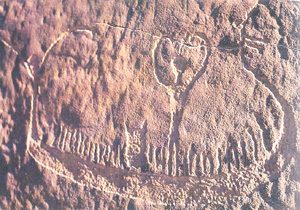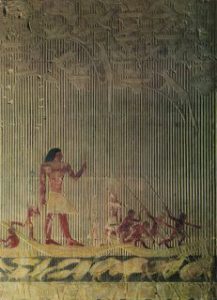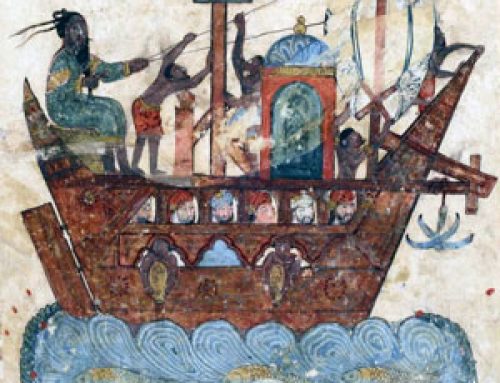
Early Egyptian wall painting: A person in a boat (Barramiya, Upper Egypt, ca. 4000 BC)
Stone Age rock carvings
The earliest art from North Africa is carvings of giraffes and other animals on stones in the Sahara desert starting about 10,000 BC. At about the same time in West Asia, artists were also carving animals onto rock faces. By about 7500 BC, Egyptian artists were also carving on rocks, especially in Upper Egypt (southern Egypt).

Egyptian wall painting from the Tomb of Ti, who is watching a hippopotamus hunt – 5th Dynasty Old Kingdom (ca. 2400 BC)
Old Kingdom tomb paintings
Around 3000 BC, Egyptian artists began to create their own rock walls to carve and paint, by building stone buildings. Most of the buildings we have left are mastabas, which were the burial places of rich people when they died. The pictures carved and painted on the walls of these mastabas were supposed to help the dead person out when he or she reached the next world, where the Egyptians thought you lived after you died in this world. So the paintings showed all sorts of things that people did in their regular lives.
Egyptian paint colors
Egyptian painters made their paints by grinding up minerals (rocks) of the right color like red ochre, chalk, yellow ochre, and copper carbonate, and mixing them together to get the right shade. They used charcoal to get black. Then they mixed that powder with water and something sticky – either acacia gum (the sap of the acacia tree) or egg white, so it would stick to the wall. We call this kind of paint “tempera”.

Egyptian wall painting: Tomb of Setnakht, New Kingdom (ca. 1500 BC)
Middle Kingdom painting
There are big changes in style over the two thousand years that these tomb paintings were being painted. In the Old Kingdom, the carvers took great pains with the pictures, but in the Middle Kingdom, the carvers took a lot of shortcuts and did sloppier work, for instance. Probably the owners of the tombs didn’t have enough wealth to pay them as well.
New Kingdom wall painting
In the Old Kingdom, the pictures were almost always about daily life, but by the New Kingdom there were more temples being built, and on temples there were pictures about events that happened, reminding people about a big battle, for instance. Also in the New Kingdom, the Amarna period is one of great experimentation in Egyptian art as well as in religion and government.
Multiculturalism
Once the Persians conquered Egypt in the 500s BC, Egyptian art became a mixture of different cultures: Egyptian-Persian art, then Egyptian-Greek art, then Egyptian-Roman art, and Coptic and finally Islamic art. Each of these cultures mixed with Egyptian culture in a different way.
Learn by doing: Afterlife painting project
More about Egyptian sculpture
Bibliography and further reading about Egyptian art:
Eyewitness: Ancient Egypt, by George Hart. Easy reading.
Ancient Egyptian Art, by Susie Hodge (1998). Shows how Egyptian art relates to Egyptian religion and culture.
Hands-On Ancient People, Volume 1: Art Activities about Mesopotamia, Egypt, and Islam,by Yvonne Merrill and Mary Simpson. Easy art projects, though the directions are really aimed at teachers or parents.
The Art and Architecture of Ancient Egypt (Yale University Press Pelican History of Art), by William Stevenson Smith and William Kelly Simpson (revised edition 1999). The standard for college courses.
Egyptian Art, by Cyril Aldred (1985). Another standard.


